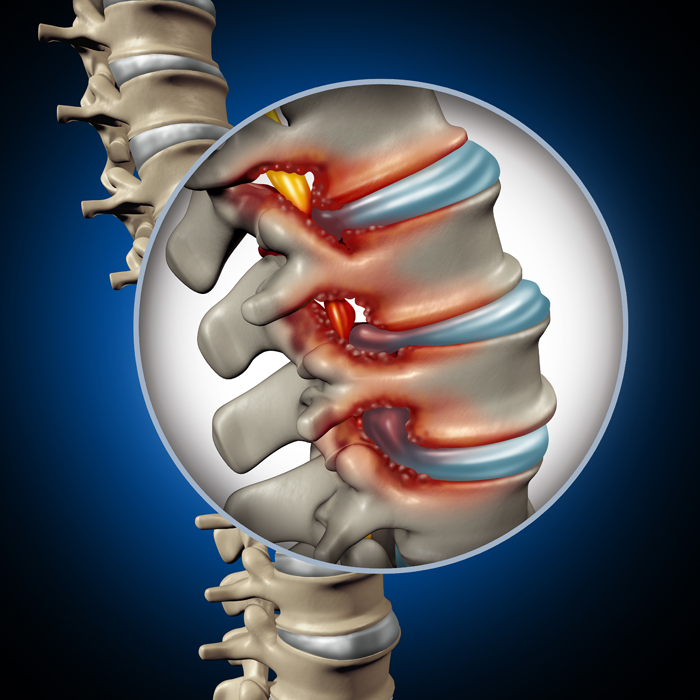Spinal Stenosis Treatment in Tardeo, Mumbai
The spinal cord that runs along our vertebral column carries signals between our brain and our body. The nerves that emerge from the spinal cord, branch out to form the complex network of our nervous system. The spinal canal is shaped in such a way that the cavity provides enough space for the nerves to connect to the spinal cord.

What do we need to know about spinal stenosis?
Spinal stenosis is a vertebral disorder that causes these spinal spaces to narrow, which in turn puts pressure on the nerves. Tightened spaces in the vertebrae can cause these nerves to irritate, pinch and compress. Spinal stenosis can cause symptoms of back pain, sciatica or cauda equina compression.
What are the types of spinal stenosis?
Spinal stenosis is closely related to osteoarthritis, as the wear and tear can cause the spinal spaces to deteriorate. This is because the symptoms of this disorder are mostly observed among people, usually above the age of 50.
The two types of spinal stenosis are classified by the part of the spine at which the narrowing is observed. These two types are:
- Cervical stenosis: When the narrowing occurs at the neck part of your spine, causing the nerves in your neck to hurt.
- Lumbar Stenosis: As the most common form of spinal stenosis, the narrowing is observed in the lower back of your spine, compressing the nerves in your lower back.
To seek treatment for spinal stenosis, you can search online for a spinal stenosis doctor near me or a spinal stenosis hospital near me.
What are the symptoms of spinal stenosis?
Patients with spinal stenosis can experience a range of symptoms, from mild to extreme, depending on the type of stenosis, impact, age and a few circumstantial factors such as accidental damage. Some of the symptoms of spinal stenosis are:
- Lower back pain
- Sciatica
- Numbness of the legs, pain, cramps, weakness
- Pain when standing, walking, climbing, bending
- Loss of motor control of legs
- Loss of bladder, bowel control
- Neck pain
- Weakness in hands, pain, shaking
- Loss of function of hands, fingers
- Paralysis (extreme cases)
What causes spinal stenosis?
Spinal stenosis could be caused by a variety of factors, which lead to the narrowing of the space around the spine, and the nerve roots that emerge from the spine. Some of the primary causes of spinal stenosis are:
- Arthritic spurs/bone overgrowth
- Herniated disk
- Thickening of ligaments
- Spinal injuries or fractures
- Spinal cord cysts/tumors
- Spinal deformities
When do you need to see a doctor?
In some cases, spinal stenosis does not display any symptoms. In most of the other cases, back pain, neck pain or other symptoms are observed among patients. If you experience back pain while walking or while standing up or any other signs of spinal stenosis, you should consult a spinal stenosis specialist near you.
If your back pain has been worsening, you should seek an appointment with a pain management doctor. If a recent accident or injury has triggered pulsating or intense back pain, you must visit a doctor immediately.
Request an appointment at Apollo Spectra Hospitals, Tardeo, Mumbai.
Call 1860 500 2244 to book an appointment.
How is spinal stenosis treated?
The prescribed form of treatment for spinal stenosis depends on the location and severity of the narrowing. Apart from cold compress and exercising, patients are recommended the following treatments for spinal stenosis:
- Medications: NSAIDs (non-steroidal anti-inflammatory drugs) such as naproxen, ibuprofen and acetaminophen can reduce inflammation and offer relief from back/neck pain.
- Steroidal injections: Injecting corticosteroids near the space where nerves are pinched and aching, can reduce the pain, inflammation and irritation.
- Physiotherapy: Physical therapy can slowly ease the pain and reduce the pressure on the nerves of your spine.
- PILD - Percutaneous Image-guided Lumbar Decompression is used for the treatment of spinal stenosis that is caused by the thickening of ligaments.
- Laminectomy - This surgical procedure includes removal of the lamina from the spine, and some bone spurs and ligaments, to relieve extreme pain caused by spinal stenosis.
- Spinal Fusion - Two vertebrae are joined together permanently, through surgical procedures, by holding them together with screws and rods for a few months until they heal.
Conclusion
Spinal stenosis is one of the major disorders of your vertebral column, which is painful and often age-related. Eating a healthy diet, exercising regularly, and maintaining a good posture can help you prevent spinal stenosis to some extent.
No. Spinal stenosis cannot be reversed, but the deterioration can be slowed down if you maintain a healthy weight, diet and exercise regime.
Depending on the exact surgical technique, the recovery period could range from 8 weeks (laminectomy) to 6 or more months (spinal fusion).
If osteoporosis has caused your spinal stenosis, then it will not heal on its own. But if a herniated disk has caused it, treating the displaced disk can help in healing spinal stenosis faster.
Symptoms
Our Doctors
DR. SURBHI P. BHAGAT
MBBS, MD - Anaesthes...
| Experience | : | 21 Yeras Experience |
|---|---|---|
| Speciality | : | Pain Management... | Location | : | Tardeo |
| Timings | : | Mon to Sat : 01:00 P... |
Our Top Specialities
NOTICE BOARD
CONTACT US
CONTACT US
 Book Appointment
Book Appointment



.svg)
.svg)
.svg)
.svg)








